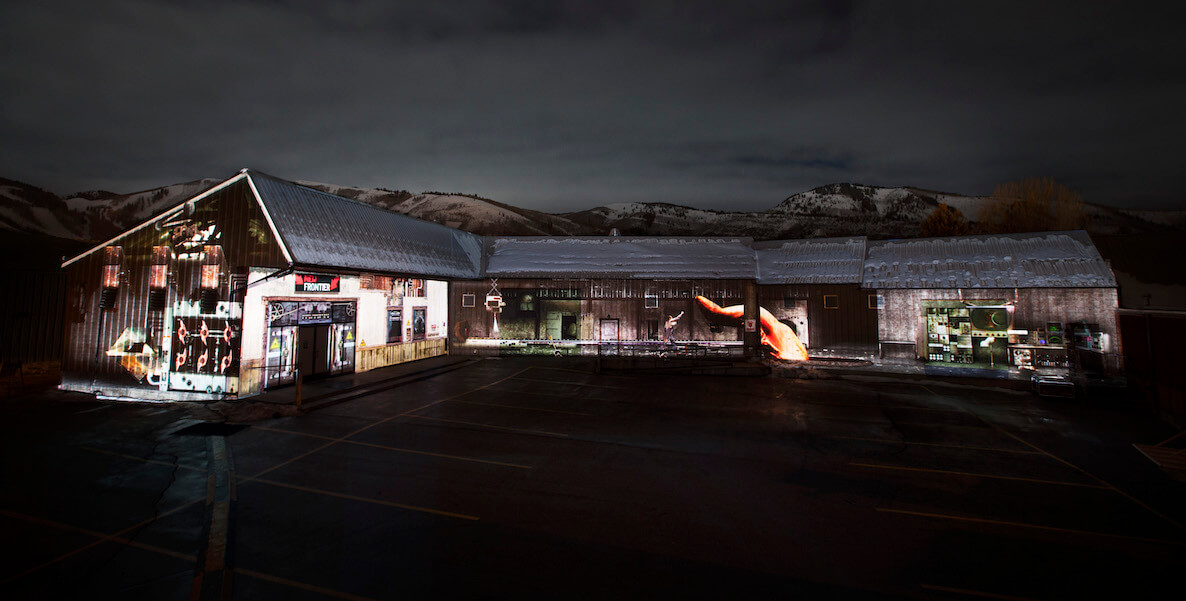Many Phiadelphians know Klip Collective from their Deck The Hall Light Show, which, for the past few years, has shown on the western façade of City Hall every evening in December. When the sun goes down, bright projections animate the building with a dazzling, festive light display. This show is what’s called projection mapping: When a projected video mimics the object’s shape so that as the video changes, the object appears to transform as well — shifting in color, texture or even size.
This July will mark the 20th anniversary of Klip Collective, a team of creatives led by Ricardo Rivera. Rivera founded Klip Collective to support his breakthrough work in projection mapping. At a time when immersive art pop-ups are all the rage, Rivera focuses on site specificity. This attention to detail has allowed Klip Collective to work with some of the biggest brands in the world: Nike, Target, Adidas and Adult Swim to name a few. Currently, Klip Collective has re-mounted Night Forms at Grounds For Sculpture in Hamilton, NJ, on view through April 2.
Despite much commercial success, the core of Rivera’s work has always been underground music. Rivera got his start VJing raves in the 1990s, and he still performs live visuals for parties and shows. Dave P, a local DJ and event producer, is a longtime friend and collaborator of Rivera. Together they have made Making Time the party of choice for Philadelphians looking for an illuminating and transcendent experience.
“I’ve figured out a way to survive and thrive and actually run a company doing this weirdo stuff,” says Ricardo Rivera.
Logan Cryer: Can you tell me how you got started in projection mapping?
Ricardo Rivera: I went to the University of Delaware and I had made a film that had all original music in it. And one of the composers was this electronic music artist, Bill Fields. I remember after we finished the film, he was like, “Hey, we’re doing this show in the basement of the student center, and I’m playing a live set of ambient electronic stuff. There’s some VJs coming from Baltimore. You want to do some video stuff?” And I was like, “Cool.”
I had this weird-ass video projector that was an old Avon sales projector. It was so heavy. It said Avon on the case. It was so weird. I got it at a yard sale. But it worked. It was like a CRT style projector. So I had that, and then there was this video mixer. I taught myself all the video stuff.
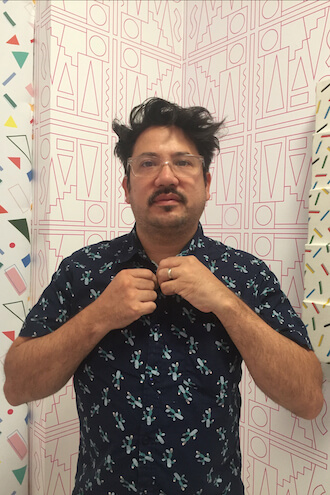
I’d never taken a video class, but at the University of Delaware there was a student-run television station, and that was my second home. I literally slept there all the time. And they had a nonlinear editing system. That’s where I taught myself how to edit video. They had an old video mixer in the closet. I was like, Oh, this is like a DJ mixer! So I brought two VCRs, I made a bunch of trippy mixes, like loops, and I plugged the mixer into the projector. I had an Atari hooked up to it and everything. So I was just projecting and mixing live to music. Never done it before. I just thought it’d be cool.
Well, these guys from Baltimore were there. They had a group called Sonic Soul, and they put on this show called CloudWatch, which was an amazing ambient downtempo electronic event that happened. And they were like, “We’ve been to Europe and the UK, and this is called VJing. What are you doing next week? We have a warehouse party. We want you to be there and we’ll pay you.” And that was the next week. I was at a warehouse party in Baltimore, doing visuals and that was in the 90s.
That started this whole weird journey into that scene. And I just fell in love with it.
What did you love about it?
As a filmmaker, I struggled with video art in general at that time. I was struggling trying to find my voice, and I was trying to figure it out. Doing live visuals to music was really cool because it was performative; it was abstract; it was flow. I loved playing these video mixers as instruments. I remember, one time, I was in the drum and bass room at this rave at the DC Armory, and it was insane. It was like, Grooverider, LTJ Bukem. It was massive. But I almost broke everything that day.
Anyway. I started doing that, and it was cool. And that’s when I started messing around with projectors in space and transforming space. Because the cool thing about that scene was, Oh, we’re going to do a party in this weird warehouse. How do we make it cool? Let’s project on some stuff.
Says Rivera, “That’s the thing I love about this work: It’s so meditative and transformative.”
And then that’s how I started messing around with projectors and video gear and doing non-traditional things with video, like video feedback, which is now a huge part of my work. I moved to Philly in 2000. And it’s funny, when I was in Philly, I actually didn’t score a gig for a whole year … I was just going down to Baltimore, D.C. and New York, doing other shows.
Why did you move to Philadelphia?
I did the thing that I tell all my friends not to do — which is move to a city for a girl. So the woman I was dating was going to a grad school at Penn. We moved to Philly together. Sidebar, I always tell people not to do that, because then people break up and they’re like, “Why am I in this city?” But that person was Michelle Barbieri, who runs Klip Collective and is the mother of my two kids. So we managed to weather that storm, which is awesome.
Eventually, I met people. I met Dave P in 2002, I think. It’s been a wild, intense relationship to say the least. But it’s funny, because I’ve watched him evolve, and I’ve evolved. It’s gotten to the point where Dave and I have become kind of a thing together. We’re becoming a package deal, as he likes to say.
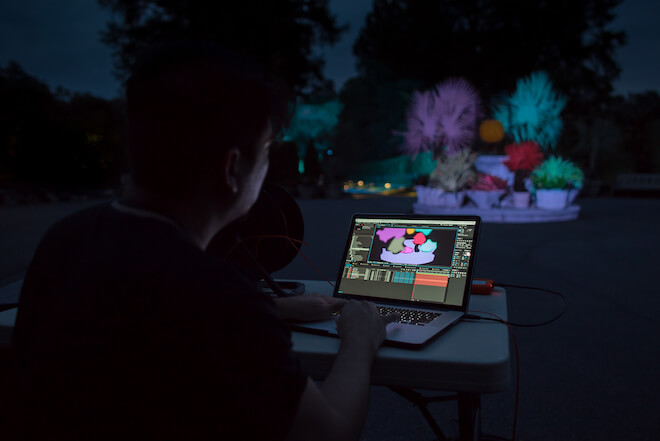
I started producing for a friend of mine who worked for this commercial photographer in South Philly, Nic D’Amico. In 2003, I projection mapped the kitchenette in my apartment on Pine Street. I mapped it all out. I did different stuff on the ceiling, different stuff on the cabinets. I’ve been mapping since like ’99, but just rudimentary. [In 2003] I really figured it out. I showed it to Nic and he was like, “You could sell this.” I was like, “Really?” And he was like, “Yeah.” So that’s how Klip Collective was conceived. It started in 2003, so it’s going to be 20 years old this July.
Over the years, Klip has evolved. We’ve evolved to be able to do this on a large scale for months at a time. It’s been such a weird transformative ride. I started Klip to have a production company to facilitate all these crazy ideas. It takes a village. I come from the filmmaking background where it’s a production. I want a producer, I want to be the director. I want to have all these people working with me to collaborate on making this thing that’s bigger than just something I can do by myself.
Could you talk more about non-commercial projects that Klip Collective has worked on?
I did this show with Joe Patitucci at Bartram’s Garden called Data Garden in 2012. I made this installation in the meadow where I projected on smoke in this meadow, and it looked cool. Then someone from Longwood Gardens saw it. So we went to Longwood, had a meeting, and they asked us to put together a proposal. We got it and we got to put on Nightscape at Longwood in 2014, which was the first time I had done multiple installations within a space, with our own soundtrack, full creative control, whatever we wanted to do. And the show was massively successful, and we were one of the first people to do something like this.
My team’s really good. We’re really good at these things, and we all love doing it. And I’ve figured out a way to survive and thrive and actually run a company doing this weirdo stuff. It’s every now and then, I got to pinch myself. I’m like, What’s going on? Is this real? Is this really what we do? And it’s great because it enables me to do things like Passages and Making Time, because I have the resources to just do it.
“I was like, ‘Yes. Now, the statues are going to puke rainbows. This is going to be so cool.’ It was awesome.” says Rivera.
I really enjoy giving back to the culture of Philadelphia. I love when people come to me now and they’re like, “Thank you so much for doing all the cool stuff in the city,” and I start crying all the time. I love this trash city so much. I love being in Philadelphia. I want to do everything I can to make it better. Now, I want to teach people and cultivate more and make a cool place for this stuff.
What is a common misconception you get about your work?
That’s a good question. I mean, I get frustrated when people put the technology first, and all they want to do is talk about the technology.
What do you mean by that?
Well, I’ll create something, and then the first thing that gets out of their mouth is like, “What programs do you use?” I’m like, “All of them. I don’t know. Why does that matter?” It’s like the people that are more interested in the technology and not letting the work wash over them. Because that’s the thing I love about this work: It’s so meditative and transformative. That’s why I like using music; it’s non-narrative, and it’s abstract. I love that stuff and that’s what I’m trying to do with the medium. I’m not trying to sell software or projectors.
Right. And that question can sometimes imply that it’s the tool that’s doing what you’re doing, not you.
Exactly. Let’s not talk about the technology. A lot of people ask, “What’s your inspiration? What inspires you to make the work that you do?” And I think a large part of my practice and processes is the site-specific part of it. It’s a very intentful thing. I’m very Zen Buddhist about that type of stuff. Let the work be the work. And that’s the truth. If you say you’re a site-specific artist, that’s something that you really need to come to terms with is let it just be what it needs to be.
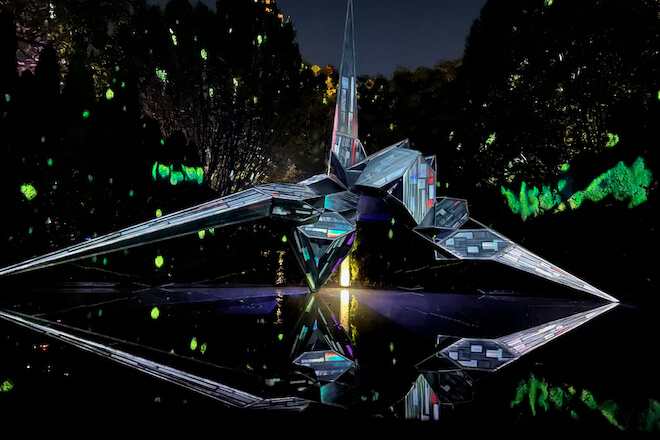
Doing that show at Grounds For Sculpture is amazing. Because, once again, total creative freedom to do whatever the hell we want. And I lean so hard into that process, where I’m just like, Let’s let it be what it’s going to be. I remember last year, the first year, we did the Frog Head Rainbow, which was in the amphitheater area. We were working on the music, which is a big part of what we do. And I’m working with Julian Grief, who’s a music director and colleague, and a really good friend. But I remember working on that piece and struggling with Julian on the song.
And then, yeah, he did this one thing, and it was kind of this Talking Heads vibe. And I remember listening through my headphones for the first time and I just saw the statues mouth moving in my head, and I just started laughing out loud. I was like, “This is perfect. This is exactly what we needed.” But once again, that’s a great example of just letting the work just happen sometimes. And then something landed, and it was awesome. And I was like, “Yes. Now, the statues are going to puke rainbows. This is going to be so cool.” It was awesome.
Logan Cryer is a curator based in Philadelphia with a penchant for local art histories. They currently serve as the Co-Curator of Icebox Project Space and they like to rewatch documentaries.
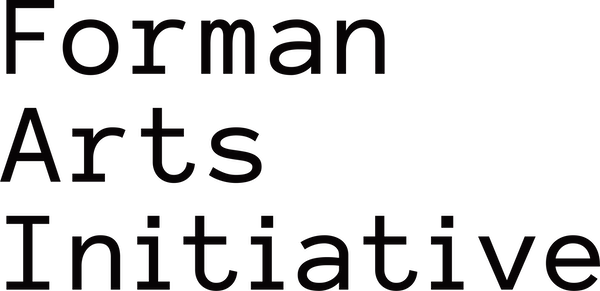 This story is part of a partnership between The Philadelphia Citizen and Forman Arts Initiative to highlight creatives in every neighborhood in Philadelphia. It will run on both The Citizen and FAI’s websites.
This story is part of a partnership between The Philadelphia Citizen and Forman Arts Initiative to highlight creatives in every neighborhood in Philadelphia. It will run on both The Citizen and FAI’s websites.
![]() MORE ART FOR CHANGE
MORE ART FOR CHANGE



